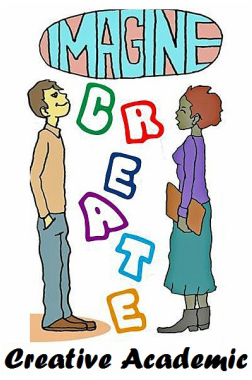
‘What makes the world go around?’ There are many possible answers to this question but one of the most meaningful is ‘imagination’. All the great thinkers understand this. Another possible answer is ‘collaboration’ – when people come together to share imaginations and do something with them there is an energy, a motivational force that connects efforts and contributions so that the whole is much more than the sum of the parts. Both these ideas and forces were brought together in the recent edition of Creative Academic Magazine which I had the great privilege of guest editing. Through it I was able to connect in a productive collaboration thinkers and practitioners in the Creative Academic and Imaginative Education communities to produce an inspiring collection of articles which explore imagination in learning, education and practice.

Imaginative Education, or IE, is not just an approach to teaching, it’s also a theory of human understanding through which we can, as educators, reshape and develop our practices. Although you might not be familiar with IE, it certainly isn’t “new”. In fact, it’s been articulated in many books and well over a thousand articles. It’s been studied in universities around the world for over thirty years and it’s been driving the work of scholars in the Imaginative Education Research Group since 2001.

IE is an educational philosophy and practice that centralises imaginative and emotional engagement in teaching at all levels of education. Imaginative educators think about teaching through different lenses. They are centrally concerned with “cognitive tools” and “kinds of understandings”. Imaginative educators tap into the unique features of their students’ emotional and imaginative lives.
Emotion Matters
Emotion Imagination Feeling: these words rarely take centre stage in conversations about teaching and learning in higher education. The odd thing is that I have never met an educator that doesn’t value emotional and imaginative engagement. All educators want students to be engaged. All educators want their students to be imaginative, to experience and demonstrate creative and flexible understanding of knowledge. But we rarely discuss how we achieve it in our practices. It’s a sad fact that there is far more talk of “imagination” in the context of educating our younger learners than in Higher Education. Through this edition of Creative Academic Magazine we want to encourage more discussion about imagination in higher education teaching and learning and share some of the ideas and work we have been doing through IE.
Cognitive tools
All educators want students to remember what they are learning so that curriculum content has an impact on their lives outside school, college or university. “Cognitive tools” are the means through which we can tie up knowledge with students’ emotions and imaginations and, in this way, make the knowledge memorable1. We all make meaning by employing cognitive tools; when we purposefully use these tools to shape our teaching, imaginative education helps learners to use their knowledge to create meaning that is more memorable.
People of all ages frequently and routinely think about the world in ways that evoke their emotions and imaginations. For example, human beings universally enjoy stories or narratives of all kinds. We all enjoy jokes and humor. We all identify and interpret patterns in the world around us and are able to spot new patterns as they emerge in our lives. We can be fascinated by extremes of experience and limits of reality--the stuff in the Guinness Book of World Records or amazing and sometimes dangerous feats recorded on Youtube.
Emotion Matters
Emotion Imagination Feeling: these words rarely take centre stage in conversations about teaching and learning in higher education. The odd thing is that I have never met an educator that doesn’t value emotional and imaginative engagement. All educators want students to be engaged. All educators want their students to be imaginative, to experience and demonstrate creative and flexible understanding of knowledge. But we rarely discuss how we achieve it in our practices. It’s a sad fact that there is far more talk of “imagination” in the context of educating our younger learners than in Higher Education. Through this edition of Creative Academic Magazine we want to encourage more discussion about imagination in higher education teaching and learning and share some of the ideas and work we have been doing through IE.
Cognitive tools
All educators want students to remember what they are learning so that curriculum content has an impact on their lives outside school, college or university. “Cognitive tools” are the means through which we can tie up knowledge with students’ emotions and imaginations and, in this way, make the knowledge memorable1. We all make meaning by employing cognitive tools; when we purposefully use these tools to shape our teaching, imaginative education helps learners to use their knowledge to create meaning that is more memorable.
People of all ages frequently and routinely think about the world in ways that evoke their emotions and imaginations. For example, human beings universally enjoy stories or narratives of all kinds. We all enjoy jokes and humor. We all identify and interpret patterns in the world around us and are able to spot new patterns as they emerge in our lives. We can be fascinated by extremes of experience and limits of reality--the stuff in the Guinness Book of World Records or amazing and sometimes dangerous feats recorded on Youtube.

We may associate with heroes and may (quietly—or not-so-quietly) idolize people, ideas, or institutions. Words cause images to arise in all of our minds. We all enjoy a good mystery and can be left awestruck by unanswered questions or strange events. In the context of Higher Education particularly, we enjoy abstract ideas and theories that represent them. I could go on and on; our emotional and imaginative lives (including learners) manifest themselves in many varied ways. These different forms of engagement are not insignificant; they are actually ways of thinking that help human beings learn. Dr. Kieran Egan calls these features of our imaginative lives "cognitive tools" they are emotional ways human beings make meaning in the world. The crux of the matter is you can nurture the heart of learning—engaging emotion with your curriculum content—if you know what cognitive tools your students employ and if you can use them in your teaching.
You can find out more about what these tools are and how they are used by reading Creative Academic Magazine CAM11A which is free to download from the magazine page.
Gillian Judson
http://ierg.ca/gillianjudson/
You can find out more about what these tools are and how they are used by reading Creative Academic Magazine CAM11A which is free to download from the magazine page.
Gillian Judson
http://ierg.ca/gillianjudson/

 RSS Feed
RSS Feed
